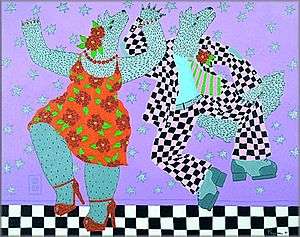Harry Fonseca
Harry Eugene Fonseca (1946–28 December 2006) was an American artist. He was born in Sacramento, California.
Harry Fonseca was of Nisenan Maidu, Hawaiian, and Portuguese heritage. He studied art at California State University Sacramento with Native-American artist Frank LaPena but quit the program to pursue his own vision of art. His earliest pieces drew from his Maidu heritage. He was influenced by basketry designs, dance regalia, and by his participation as a traditional dancer. Further, the creation myth of his people, as recounted by his uncle, Henry Azbill, became the source of a major 1977 work, Creation Story, which he would paint in many versions during his career.
Fonseca began his popular Coyote series in 1979. In it he places Coyote, the trickster, in non-traditional settings. As an example, his Coyote in the Mission depicts Coyote dressed in a leather jacket with many zippers and green hightop sneakers standing against a graffiti covered brick wall in San Francisco's Mission district. Another image has Rousseauesque Coyote sitting in a Paris cafe.
In 1981 he illustrated a book, Legends of the Yosemite Miwok, compiled by Frank LaPena and Craig Bates.
Fonseca was particularly taken by petroglyphs in the Cosco Range near Owens Lake, California, and petroglyphs from throughout the Southwest United States. In 1991 he reinterprets the Maidu Creation myth all over again using imagery influenced by petroglyphs. He began a series of paintings he called Stone Poems, that draw heavily from these petroglyphs. A series of these paintings were exhibited in the Southwest Museum (Los Angeles, California) in 1989.
Harry found another profound influence in the California Gold Rush, where his work takes a political tone. These are small abstract paintings in which gold is the predominant color, along with traces of red which represent the blood of Native Americans shed by the gold seekers. Each painting also incorporates minerals from California's gold country. Fonseca wrote that they are "a direct reference to the physical, emotional and spiritual genocide of the native people of California". Many of these were exhibited in the Crocker Art Museum in Sacramento (1992) and the Oakland Museum as part of a larger Gold Rush exhibit in 1998.
He did many drawings and prints of Coyote and Rose, a female counterpart to Coyote, often depicted in a rose print dress. These became a mainstay of Santa Fe event posters.
Harry did several other series of paintings. One series painted in the 1990s was of images of Saint Francis, who appears as negative space in each painting. About the same time he did a series of paintings of the Icarus story. Another series from 2002 was inspired by the striped patterns on early Navajo blankets.
From the early 1990s on he lived in and maintained a studio in Santa Fe, New Mexico.
In 2003 he started to paint a series of abstract paintings of flowering tree branches, which he called collectively the Four Seasons, a small group of which were exhibited at the Smithsonian's National Museum of the American Indian in New York City. He was diagnosed with brain cancer and hospitalized in the Veterans Administration hospital in Albuquerque, New Mexico in August, 2006 where he died on December 28, 2006.
The Albuquerque Museum (Albuquerque, New Mexico), the California State Parks Central Valley Regional Indian Museum (Sacramento, California), Crocker Art Museum (Sacramento, California), the Denver Art Museum, the Eiteljorg Museum of American Indians & Western Art (Indianapolis, Indiana), Ethnological Museum of Berlin (Berlin), the Heard Museum (Phoenix, Arizona), the Honolulu Museum of Art, the Hood Museum of Art (Dartmouth College, New Hampshire), the Linden Museum (Stuttgart, Germany), the Monterey Fine Arts Museum (Monterey, California), the New Mexico Museum of Fine Art (Santa Fe, New Mexico), the Oakland Museum of California (Oakland, California), Oguni Museum (Oguni, Japan), the Pequot Museum (Mashantucket, Connecticut), the University Art Museum (Berkeley, California), the Washington State Arts Museum (Olympia, Washington), and the Wheelwright Museum of the American Indian (Santa Fe, New Mexico) are among the public collections holding work by Harry Fonseca.
References
- Official website with Biography, Exhibition History, and Sample Images
- Discovery of Gold In California Paintings
- Harry Fonseca's "Koshares with Cotton Candy"
- "A Time of Visions" - an interview with Larry Abbott
- Abby Wasserman article on Harry from 1987
